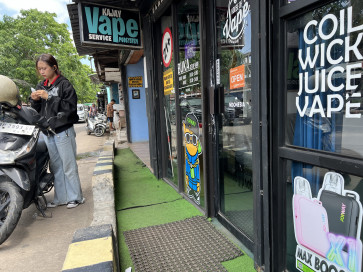Popular Reads
Top Results
Can't find what you're looking for?
View all search resultsPopular Reads
Top Results
Can't find what you're looking for?
View all search resultsSAGIO: Striving to preserve wayang
Sagio, 60, is one of only a few Yogyakarta-style wayang kulit (leather shadow puppet) craftsmen who has managed to survive difficult times
Change text size
Gift Premium Articles
to Anyone
Sagio, 60, is one of only a few Yogyakarta-style wayang kulit (leather shadow puppet) craftsmen who has managed to survive difficult times.
Learning about shadow puppet craftsmanship from his father, Jaya Perwita, beginning at age 11, Sagio has nurtured a deep love of wayang throughout his life.
“It’s wayang that has enabled me to tour the world to introduce the Indonesian art. But it’s also wayang that makes me feel sad and anxious. I keep crafting wayang because I love it. Wayang has helped me survive, and now it’s my turn to preserve it,” said the father of three.
The recipient of the government’s Upakarti Award in 1990 for his devotion to Yogyakarta-style wayang has finely crafted over 250 wayang puppet characters. No wonder that between 1980 and 1990 his works were collected by various museums and sold at high-end hotels in Jakarta.
Sagio lives in Gendeng hamlet in Bangunjiwo Kasihan, Yogyakarta. The village is known as a center of leather puppet makers.
During the area’s wayang heyday between 1988 and 1997, more than 150 wayang makers could be found there. The hilly area teemed with tourists from Holland, France, America, Germany, Australia and Japan.
“At the time, 75 percent of wayang products from this hamlet were purchased by foreigners and only 25 percent by local buyers. But after the economic crisis in 1997 and the Bali bombing in 2002, everything was ruined. Our hamlet was deserted and most craftsmen failed to survive. Terrorist acts further deterred tourist visits and now only about 54 wayang makers are left,” said Sagio, whose 50 assistants have been reduced to only five.
According to the craftsman, while many foreign tourists are fond of wayang puppets as souvenirs, some also learn how to craft the puppets and even try to grasp the philosophy behind the characters. Wayang puppets have been a traditional gift from Yogyakarta since the era of Sultan Hamengkubuwono I.
“Foreign tourists greatly appreciate wayang. Sadly, this attitude isn’t fully shared by their domestic counterparts … But I can understand because appreciation of works of art usually develops in prosperous countries, while Indonesia hasn’t experienced such prosperity so they are less consumed,” he said.
Under such circumstances, Sagio also has to be realistic. Known as someone who adheres to standards of quality, he used to refuse to sell wayang puppets as souvenirs. But this approach wouldn’t have kept his business running today, so he also sells his friends’ wayang and leather handicraft products at his gallery and wayang workshop, Griya Ukir Kulit Wayang.
“Yogya-style wayang standards are those required by the Yogyakarta Palace, involving refined chiseling, painting and coloring work as well as philosophical weight, which I have followed up to the present. But I also sell souvenir-style wayang puppets to support my income,” explained the man who in 2012 received an award from the Tourism and Creative Economy Ministry, with a smile.
Determined to preserve the art, he prepared a generation of successors in his village from 1971 to 1997, with 50 youth trained in wayang craftsmanship. “They learned wayang crafting techniques for six months, or 500 hours. After mastering the basics, they developed their skills and were later allowed to work here or independently. This free training was for regeneration and the creation of a wayang makers’ village,” said Sagio.
Regrettably, only 20 of his 50 students continued to produce wayang, while Sagio himself couldn’t do much to help them because wayang making no longer guaranteed a proper living.
Nevertheless, he had another way of imparting his knowledge for wayang preservation.
Sagio learned wayang crafting between 1967 and 1975 from a famous empu (master craftsman) of classical wayang at the Yogyakarta Palace and a forerunner of wayang makers in the hamlet, Mas Bekel Prayitno Wiguna, better known as Mbah Bundu. Sagio wrote down all the skills and techniques he learned from the teacher in a book released by a publisher in Jakarta in 1991.
“I only wished to share my knowledge with anybody willing to learn to preserve wayang. The book came in 4,000 copies and I funded the publication at a cost of Rp 4 million [US$417],” he said while happily preparing a revised edition of the book.
In yet another attempt to preserve this sacred art, the man who has served the Yogyakarta Palace with the official name Mas Lurah Perwita Wiguna since 1978 enthusiastically accepted the offer to teach wayang crafting techniques in the Wayang Department of the Indonesian Arts Institute (ISI) in Yogyakarta in 1997.
To his regret, the department only lasted three years.
“Nobody else was interested in wayang making. There were still four students when I last taught and no more thereafter. I was happy at first because the Dalang (Puppet Master) Department was still there, with the Wayang Department to match. But the reality was different,” said the junior high school graduate in a flat tone.
According to Sagio, the fate of wayang contrasts to that of batik. The government still shows some concern about batik preservation by promoting batik uniforms for civil servants and even including the art in school lessons.
In the future, Sagio believes Yogyakarta-style wayang is likely to remain at the Yogyakarta Palace while disappearing in public. It is fresh in Sagio’s mind that Purworejo, especially Kaligesing, and also Kedu and Madura used to be famous centers of wayang craftsmen with their respective unique styles.
It is deplorable, though, that all of them have become memories of the past, he said.
“Those who wish to see Madura-style wayang characters should go to Germany, where a German collector has bought and kept a complete set, while the whereabouts of Kedu or Puworejo leather puppets are anyone’s guess,” Sagio said with concern.










